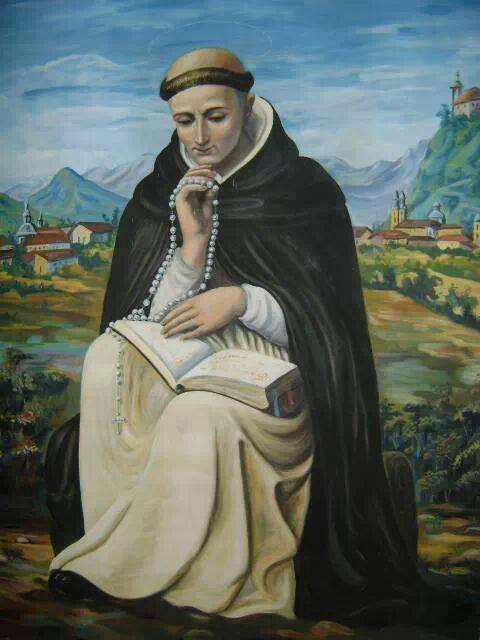
AUGUST 4 is the traditional feast day of ST. DOMINIC de GUZMAN (+1221).
Dominic, son of Felix de Guzman and Juana of Aza, was born August 8, 1170 in Calervega, Spain. He was named after St. Dominic of Silos, whose namesake Benedictine monastery, was close by.
As a young man, Dominic studied arts and theology at Palencia. In 1191, there was a great famine in Spain. Being from a fairly wealthy family, Dominic gave away his money and sold his clothes, books and furniture to feed the hungry, much to the chagrin of his classmates.
Three years later, Dominic joined the Canons Regular in Osma, where they followed the Rule of St. Augustine. He was very strict with himself, abstaining from meat, observing stated fasts and periods of silence. He selected the worst accommodations for himself and the poorest clothes. He denied himself a bed and frequently traveled barefoot. Dominic was described as thin and of medium height. He was fair and handsome. His hair was reddish, with a few greys as he got older, tonsured but not bald. His hands were long and fine. And, for a preacher, his voice was pleasingly resonant.
Almost ten years after Dominic joined the Canons Regular, he accompanied Bishop Diego de Acebo of Osma to Denmark, representing the king of Castile, to find a bride for Crown Prince Ferdinand. The negotiations were successful, but the bride died before they left. Having traveled through France on their journey, they encountered Albigensians, or Cathars, a heretical group who had gnostic and dualistic beliefs. For example, “good” people lived a life of austerity because spiritual was good but physical goods were evil.
Upon returning to Spain, the bishop began to evangelize the Cathars, who were supported by the Duke of Toulouse. They started a series of public debates with the Cathars. But there were few conversions over a period of ten years.
In 1215, Dominic and six others went to Toulouse to address the spiritual needs of growing cities. They were permitted to preach anywhere in the area. The men secured a house in town and used it as their base. Soon, he left for Rome for the Fourth Lateran Council to secure permission of a new order by Pope Innocent III. A year later, permission to form the Order of Preachers was finally granted by the new Pope Honorius III.
In short order, the bishop of Toulouse granted the new order a convent for the reformation of nuns. Then the order moved their base to Rome and were given the basilica of Santa Sabina. In all this, the preachers went on educating and preaching and expanding their territory.
In August, 1221, Dominic was on his way to Bologna when he took sick from fever and exhaustion. When he got to his destination, he was very ill and asked to be put on a pallet on the floor and spent the last few hours of his life exhorting his followers to be humble.
Rumor has had it for centuries that Dominic was associated with the Inquisition. He died in 1221. It wasn’t until 1231 that Pope Gregory IX appointed Dominicans and Franciscans as traveling inquisitors for his new Inquisition. They began in Lombardy that year and expanded to Languedoc in 1234. The Inquisition was begun due to the bungling of heretical Church cases by the diocesan level courts. The Pope’s traveling court was very organized and very detailed in their collection of data. But Dominic was not there with them.
The Dominicans also were the ones to spread dedication to the Rosary, in its present form. We thank St. Dominic for his work.
“The enemies of the faith cannot be overcome like that. Arm yourself with prayer, rather than a sword, wear humility rather than fine clothes.” St. Dominic


Recent Comments